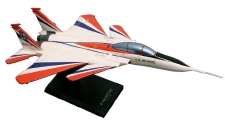 NASA Dryden's highly modified F-15B aircraft, tail number 837, serves as an Intelligent Flight Control System (IFCS) research testbed aircraft. The F-15B is a two-seat version of the F-15, which is a high-performance, supersonic, all-weather fighter airplane. The F-15B is used as a test-bed aircraft for a wide variety of flight experiments. In support of this use, a flight-test fixture (FTF) was developed to provide a space for flight experiments in a region with known aerodynamic conditions. The FTF is a fully instrumented test article mounted on the center line of the bottom of the fuselage of an F-15B airplane. The FTF includes an interchangeable experiment panel and is 107 in. (2.72 m) long, 32 in. (0.81 m) high, and 8 in.(20.3 cm) wide, with a 12-in. (30.5-cm) elliptical nose section. The FTF has been used in many flight experiments during the past several years and can be modified to satisfy a variety of research requirements. NASA Dryden's highly modified F-15B aircraft, tail number 837, serves as an Intelligent Flight Control System (IFCS) research testbed aircraft. The F-15B is a two-seat version of the F-15, which is a high-performance, supersonic, all-weather fighter airplane. The F-15B is used as a test-bed aircraft for a wide variety of flight experiments. In support of this use, a flight-test fixture (FTF) was developed to provide a space for flight experiments in a region with known aerodynamic conditions. The FTF is a fully instrumented test article mounted on the center line of the bottom of the fuselage of an F-15B airplane. The FTF includes an interchangeable experiment panel and is 107 in. (2.72 m) long, 32 in. (0.81 m) high, and 8 in.(20.3 cm) wide, with a 12-in. (30.5-cm) elliptical nose section. The FTF has been used in many flight experiments during the past several years and can be modified to satisfy a variety of research requirements.
Additional Information
One method of measuring turbulent fluctuations of density and velocity across the compressible boundary layer of an aircraft surface in flight (which fluctuations give rise to Reynolds stresses) involves the use of a recently developed automated hot-wire anemometry system. Prior to the development of the automated hot-wire anemometry system, a method of measuring turbulent velocity fluctuations in flight had not been perfected and routinely used in NASA's flight experiments, primarily because of the limitations of conventional anemometry systems. Conventional anemometry systems are characterized by difficulties in tuning, poor signal-to-noise ratios and low bandwidths at low overheat ratios, sensitivity to electromagnetic interference, and vulnerability to effects of cable capacitance. The automated hot-wire anemometry system is, more specifically, a constant-voltage anemometry (CVA) system that has been shown not to be subject to the aforementioned deficiencies of conventional anemometry systems. The CVA system was selected for flight testing on the FTF on the F-15B airplane. It is essential to characterize the turbulent boundary layer in flight experiments because the length scales characteristic of turbulence in wind-tunnel experiments are significantly different from those of turbulence in flight. Thus, flight measurements in turbulent boundary layers are necessary for validation of computational fluid dynamics (CFD) computer codes and for predicting transitions from laminar to turbulent flow. The specific objective of the flight tests was to validate the concept of CVA for measuring velocity fluctuations in turbulent boundary layers in flight.
|